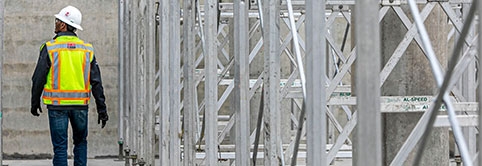Leadership in Lean
Introduction to Leadership in Lean
In Lean, as in all types of projects, teams are only as strong as their leadership. Strong leadership can shepherd a team through a tough project, guiding its members through tough obstacles and encouraging innovation. A team with weak leadership may have processes filled with waste, a lack of motivation, and an inability to effectively problem solve.
On top of that, Lean project delivery is a major change compared to traditional project delivery models, requiring a number of process changes and the shifting of thought compared to how work is normally done in the design and construction industry.
While a Lean approach helps teams produce projects with more value and less waste, integrating this method requires top-down shifts, and that includes leadership structures.
Because Lean is grounded in the ability of any member to speak up to discuss a problem or to suggest a change, every team member at the project level needs to feel comfortable in a leadership role. A proper leadership structure should enable team members to feel empowered when they have something to say.
Meanwhile, leaders at the executive level must be committed to helping the team and involving themselves directly when they can provide value to the project.
Leadership and Lean IPD Projects
Successful implementation of Lean concepts requires strong leadership from the top-down, at both the executive level and the project level. It is important that all members of the project team develop leadership skills in order to help the team continuously improve processes and innovate.
Lean Leadership Styles
Successful implementation of Lean concepts requires strong leadership top-down. Below are a couple of leadership styles that have thrived in Lean settings.
Servant Leadership
What is Servant Leadership?
Servant leadership is a leadership style in which the assigned leader prioritizes the growth of the team, its members, and their overall well-being. The leader is a “servant” to the team and the interests of its members, as opposed to serving the interests of the organization.
Benefits of Servant Leadership
When work becomes difficult, it is human nature to revert back to old habits. This means that a team that is newly implementing Lean concepts may knowingly or unknowingly go back to traditional delivery methods if left unchecked. One role of servant leaders is to keep these project teams in check and let them know when they’ve strayed from the mission.
Rather than commanding the project from a chair of power like in some traditional leadership settings, a servant leader is the first to rush to the scene during a breakdown in the project. The servant leader is actively helping the team. In this setting, team members are relieved when leadership shows up rather than dreading or fearing it. This leads to higher team morale and a higher level of focus on the work.
Distributed Leadership
What is Distributed Leadership?
Distributed Leadership is a leadership model that distributes the leadership duties among many members of the team, in which each member has an area of the project they are responsible for at a given point in time. The responsibility may shift as the project shifts.
Benefits of Distributed Leadership
Lean project teams function best when every team member is capable of leading. The goal of Distributed Leadership is to provide every member with an opportunity to learn how to lead and to have a section of the project that they feel responsible for. This distribution of duties also lessens the pressure placed on individual members, a spreading of the burden that enhances the feeling of the project being a team effort.
In a Distributed Leadership setting, every team member feels comfortable enacting lasting change, and work can continue even if an assigned leader is missing from the project – where normally work may slow down or stop if someone is unavailable to lead.
But perhaps the most important aspect of Distributed Leadership is the confidence it builds in individual members to speak up and take charge when they have an idea for innovation and improvement. After all, a project team can only follow a model of Continuous Improvement if everyone feels empowered to suggest changes that will allow processes to improve.
Servant Leadership vs. Distributed Leadership
So, which do you choose for your project? Well, these two leadership styles are not mutually exclusive – in fact, they are complimentary in many regards. The ideal leadership structure has Servant Leadership at the executive level and Distributed Leadership at the project level.
Meaning, your project could be led by servant leaders at the very top, who are actively helping the progress of the project rather than giving orders from on high, while the project team itself could be operating in a Distributed Leadership setting where everyone has responsibilities they are in charge of.
Leadership vs. Management
While the two may seem synonymous, in Lean there is a marked difference between “leadership” and “management.”
Management’s purpose is to control and maintain stability, while leadership’s role is to enact change. While a manager aims to keep things stable, the leader breaks the mold and provokes team members to consider new opportunities.
Both of these roles are needed for a project to be successful.
What Makes a Good Leader?
An effective leader…
- Knows that they must resolve tensions from competing concerns.
- Produces an environment in which failing is OK, and recognizes failure as a great opportunity to learn.
- Facilitates productive conversation and knows the right questions to ask to provoke team members to spark change.
- Has the capacity to push team members in directions they may otherwise be uncomfortable with, for the good of their personal growth and the growth of the team.
- Is observant and attendant to the needs of team members, and can sense when an issue is arising.
- Puts team members in a position to succeed by assigning them tasks where they can thrive.
Leadership in Big Room Settings
Big Room meetings in Lean projects are the perfect places for new leaders to cut their teeth on becoming an effective leader in a Lean environment.
Distributed Leadership traits are crucial for operating in a Big Room setting, where all team members are expected to have the ability to contribute to problem-solving. Big Room settings provide new leaders with an opportunity to facilitate discussion, keep the team on track, and ensure that meetings are productive.
Lean Assessments
How strong is your Lean knowledge? Take a Lean assessment to determine your current state so you have a baseline for improvement. Lean assessments are available for individuals, teams, and organizations alike. Whether you’re new to Lean or are an experienced Lean practitioner, Lean assessments are a great way to get started at LCI!
TAKE ASSESSMENTMore Lean Topics
From 5s to IPD, explore popular Lean design and construction topics below.




